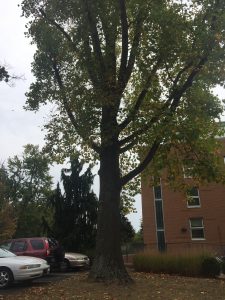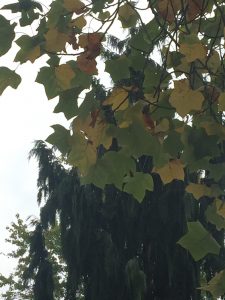The standing water is murky–a tan-grey color–and water striders tap along the surface.
I could tell that I was approaching water before I could see it by the number of mosquitoes on my arm. Two meant it was just down the hill, three meant it was around the corner, and eight meant I was standing in it.
When I was a kid my parents took me camping in Michigan. About five minutes after stepping out of the car we were over taken by this cloud of them. I remember all of us were running in circles slapping our arms and faces. I don’t remember how it stopped, I remember the days after. My eyes had been bitten so bad that they had swollen completely shut. I couldn’t see for most of that trip, so if you ask me how Lake Michigan looks I can’t honestly tell you.
As I sit here writing this they’ve gathered close. My reaction has tempered a bit since then, but I can feel one poke through my skin.
I think often of a sanitized nature. My home is near a protected wetland and some of the rich neighbors spray their lawns for mosquitoes. My family recently drained a man-made water feature that had become such a breeding ground that in order to stand being out there we’d have to stock it with feeder fish to thin the larva. There’s still mosquitoes, but it’s considerably better.
I think it’s hard to be out in nature, let alone to think of your place in it, amongst mosquitoes. I think its beautiful in theory, but I kinda can’t stand it. Rude to say, I know, but when I leave this place the sunburns and poison ivy and mosquito bites will stay with me. I cannot contain nature to nature walk, and so I pass the trees. I ignore the deep rich black of the bog. I leave behind the pristine fungal caps. Snapping quick pictures of each to consider later. I think it’s me. It’s my fault I can’t enjoy this place because I’m a suburbs kid and I have a bad hip from sitting at my desk all day. I think it’s a place better used by other people who can appreciate it better.
Perhaps this is the problem. We want the postcard. We want to focus on the trees and the wildflowers, but they live in a bog. Like it or not the bog smells and the bog bites. In nature, we realize that our comfort isn’t guaranteed and that’s the point. For Johnson’s Woods, the inhospitable parts of the land kept it safe from agriculture. It was kept safe in part by the very feature that leaves me itching my knuckles as I write this. We can’t really have the post card without the world around it.
Johnson’s woods is a beautiful sight. It’s truly stunning to see the great old tree alive in front of you, and the great old corpse sitting beside it adorned with a crown of mushroom caps and a skirt of lacy fungus. But Johnson’s woods is also a smell–the smell of greenery and decay and stagnant water. It’s also a feeling–the feeling of hot sweat rolling down your back in the heat and of mosquitos swarming around you and the poor chipmunk under the boardwalk. Mosquitoes kind of suck, but that’s the cost of these trees.



